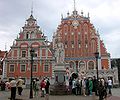Dutch Renaissance


The term Dutch Renaissance is used to distinguish the Northern European variant of this architectural style from the “classical” Renaissance influenced by Italy . The term is not to be understood in today's geographical or political context; the Burgundian and Spanish Netherlands were still part of the Habsburg and Holy Roman Empire in the 16th century . Although the inspiration for this style came from the Netherlands, it spread in northern Europe to Scandinavia . This is why people often speak of the Nordic Renaissance in analogy .
The transitions between the Dutch Renaissance and the other Nordic forms of this epoch, such as the Brick , Weser and Lipper Renaissance , are partly fluid and an exact delimitation is not possible everywhere.
The Dutch Renaissance in Architecture
The architecture of the Renaissance, developed in Italy in the 15th century, arrived late in the countries north of the Alps, the new impulses were interpreted more freely with increasing spatial distance. Characteristic for the development of the northern Renaissance style is, on the one hand, the extensive lack of ancient models to which the Italian Renaissance (French: rebirth ) referred, and, on the other hand, the continuation of the architectural forms of northern Europe originally determined by the Gothic , which in turn only exist in Italy a less common form.
The builders and artisans of this style are - unlike many of their southern colleagues - often unknown, one of the better-known exceptions being the members of the Flemish artist family Steenwinckel . The builders of the time only got to know the Italian models occasionally, educational trips like them for example the Flame Cornelis Floris undertook and which were obligatory for later architects, rarely took place. This resulted in idiosyncratic interpretations of the Italian Renaissance and antiquity, the buildings of which in the north were best known through travel reports and copperplate engravings.
The Dutch Renaissance is characterized by the frequent - but not exclusive - use of brick , which was divided by horizontal elements made of sandstone; The use of colored plaster was also less common. It took over traditional, local forms of construction and only translated construction details into the new design language. Small decorative columns, window crowns based on Italian models, e.g. B. the triangular gable borrowed from temple architecture , or the use of decorative obelisks on the front sides of the staggered and often curved building gables. Open arcades are also relatively common.
The northern renaissance differs from the southern variant through the frequent use of rolling , fittings and cartilage . Façades are often adorned with decorative wall anchors , often without any technical use. Towers on both secular and sacred buildings often had a polygonal floor plan and were given multiple perforated and curved copper domes.
Completely new buildings of this style were initially rare and existing structures were often only supplemented or rebuilt, so that there are many hybrid buildings in both profane and, above all, sacred architecture , in which older components of the Gothic are combined with the new forms. The proportions typical of southern Renaissance buildings based on mathematical principles, such as the golden section , were mostly completely missing. In the community center, the medieval-style gabled house with a steep roof remained predominant in the sacred building, the hall church .
gallery
The Westerkerk in Amsterdam
The City Hall in Leiden
Reinbek Castle near Hamburg
Ahrensburg Castle near Hamburg
The House of the Blackheads in Riga
Town house in Stade
The Dutch Renaissance in Painting
The concept of the Dutch Renaissance is used not only in architecture, but also in painting. At that time the Netherlands was one of the European economic centers and the wealthy upper class promoted numerous artists. The old Dutch painting assumed a predominant position in Europe and for the first time everyday motifs and still lifes were made on a larger scale, while religious motifs had dominated until then. The most famous artists of the time included members of the Brueghel family and Jan van Eyck . Dutch Renaissance painting led directly into the so-called Golden Age .
literature
- Hans Koepf : Architecture in five millennia. Kohlhammer, 1990. ISBN 3170110721
- Pevsner, Honor, Fleming: Lexicon of World Architecture. Prestel, 1992. ISBN 3791320955
- Wilfried Koch: Architectural style. Bertelsmann, 2005. ISBN 3577104570
- Krista de Jonge, Konrad Ottenheym: Unity and discontinuity. Architectural relations between the Southern and Northern Low Countries 1530-1700. Turnhout 2007.








